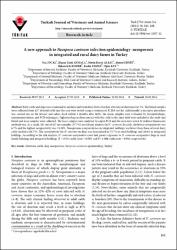| dc.contributor.author | Ocal, Naci | |
| dc.contributor.author | Atmaca, Hasan Tarik | |
| dc.contributor.author | Albay, Metin Koray | |
| dc.contributor.author | Deniz, Ahmet | |
| dc.contributor.author | Kalender, Hakan | |
| dc.contributor.author | Yildiz, Kader | |
| dc.contributor.author | Kul, Oguz | |
| dc.date.accessioned | 2020-06-25T18:12:30Z | |
| dc.date.available | 2020-06-25T18:12:30Z | |
| dc.date.issued | 2014 | |
| dc.identifier.citation | Öcal N., Atmaca T., Albay M. K., Deniz A., Kalender H., Yıldız K., Kul O. (2014). A new approach to Neospora caninum infection epidemiology: neosporosis in integrated and rural dairy farms in Turkey. Turkish Journal of Veterinary and Animal Sciences, 38(2), 161 - 168. | en_US |
| dc.identifier.issn | 1300-0128 | |
| dc.identifier.uri | https://doi.org/10.3906/vet-1307-11 | |
| dc.identifier.uri | https://hdl.handle.net/20.500.12587/5942 | |
| dc.description | YILDIZ, Kader/0000-0001-5802-6156; ATMACA, HASAN TARIK/0000-0001-8379-4114 | en_US |
| dc.description | WOS: 000331515700008 | en_US |
| dc.description.abstract | Both cattle and dogs were examined in modern and rural dairy farms that had a history of abortion over 5%. The blood samples were collected from 427 aborted cattle and the sera were tested using a commercial ELISA test kit. Additionally, a necropsy procedure was carried out on the fetuses and calves dead within 2 months after birth; the tissue samples were evaluated by histopathologic, immunoperoxidase, and PCR techniques. Eighteen dogs in close contact with the cattle in the same field were included in the study and blood and feces samples were collected. The feces samples were analyzed by copro-PCR and the sera were tested by indirect fluorescent antibody test. As a result, 161 out of 427 sera samples (37.7%) were found positive for N. caninum. In cattle, the lowest seropositivity was 6.7% and the highest seropositivity was 74.24%. Neosporosis seroprevalence in integrated holdings was lower than those of rural dairy cattle facilities (66.7%). The seropositivity for N. caninum in dogs was determined as 72.7% in rural holdings and 28.6% in integrated holdings. According to the risk analysis, N. caninum-seropositive cows had greater exposure to N. caninum-seropositive dogs in rural family holdings and integrated holdings (P = 0.054, odds ratio = 0.929; and P= 0.008, odds ratio = 0.986, respectively). | en_US |
| dc.description.sponsorship | Kirikkale University Scientific Research CouncilKirikkale University [2008/44] | en_US |
| dc.description.sponsorship | The authors would like to thank Assistant Professor Serkan Erat from Kirikkale University, Faculty of Veterinary Medicine, for his help with statistical analysis. This project was supported by the Kirikkale University Scientific Research Council (Project number: 2008/44). | en_US |
| dc.language.iso | eng | en_US |
| dc.publisher | Scientific Technical Research Council Turkey-Tubitak | en_US |
| dc.relation.isversionof | 10.3906/vet-1307-11 | en_US |
| dc.rights | info:eu-repo/semantics/openAccess | en_US |
| dc.subject | Abortion | en_US |
| dc.subject | cattle | en_US |
| dc.subject | dog | en_US |
| dc.subject | neosporosis | en_US |
| dc.subject | Neospora caninum | en_US |
| dc.subject | epidemiology | en_US |
| dc.subject | Turkey | en_US |
| dc.title | A new approach to Neospora caninum infection epidemiology: neosporosis in integrated and rural dairy farms in Turkey | en_US |
| dc.type | article | en_US |
| dc.contributor.department | Kırıkkale Üniversitesi | en_US |
| dc.identifier.volume | 38 | en_US |
| dc.identifier.issue | 2 | en_US |
| dc.identifier.startpage | 161 | en_US |
| dc.identifier.endpage | 168 | en_US |
| dc.relation.journal | Turkish Journal Of Veterinary & Animal Sciences | en_US |
| dc.relation.publicationcategory | Makale - Uluslararası Hakemli Dergi - Kurum Öğretim Elemanı | en_US |
















